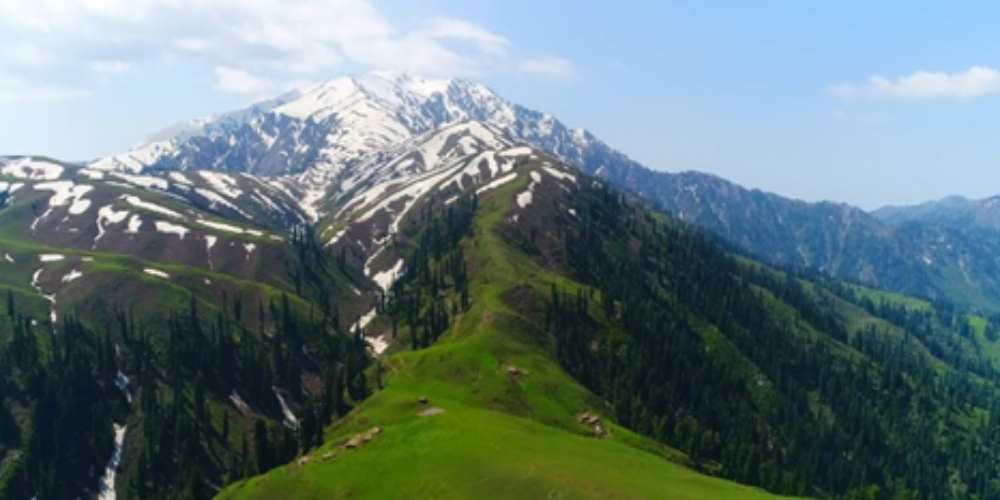Outdoor treks and activities were confined by the Covid protocols during the summers of 2020. However, the change in the Covid policy prompted us to first do the very challenging Baroghil and Koramber Lake trek during early September. Then, we planned to trek the Makra Peak at 3885 meters or nearly 13000 feet above the sea level.

It is located along the western limits of the Himalayas. Makra is approached from Kawai in the Kaghan Valley from where an ill-kept seven kilometres road leads to the popular hill resort of Shogran at 7700 feet. Another half hour’s jeep ride takes you to the Sri Paye meadows at 9500 feet which is the kick-off point for the climb. Makra Peak can also be approached from Muzaffarabad in AJK. It draws its appellation from ‘makra’ or the spider like configuration of its extended summit.

Makra Peak during Winter
I am writing this piece in February 2022 and by now we have done close to a dozen treks up north. All were thoroughly enjoyable, and we did our bit in promoting eco-tourism. Some were challenging, and Makra Peak was one of them. With respect to Makra one can access number of trekking accounts, but they provide scant guidance on the actual climb. More focus on the access part across the Sri Paye meadows
Therefore, an average trekker tends to underestimate the degree of difficulty entailed. Seen from Sri Paye, the Makra Peak seems an easy extension of the gradually rising meadows which is quite contrary to what one experiences during the climb. There is no water source ahead of Sri Paye and most of the trek route is devoid of shade that causes dehydration. There are accounts of fatalities occurring due to disorientation in fog / poor visibility and slippages along the stiff incline.

Makra Feature behind the Sir Paye Lake
Myself, Imtiaz, Asad and Amin left Islamabad on 2 October 2020 to reach Shogran by the evening. The average age of our trekking group was around 60 years. Two falling well over its wrong side. We requested our hotel to provide a trekking guide and a jeep to take us to Sri Paye early morning. However, I chose to trek for an hour and half on the incline from Shogran to Sri Paye while others wisely came in the jeep. This trek should not have been done as I experienced excessive tiredness while ascending Makra
We left Sri Paye by mid-morning on 3 October and trekked across the green meadows and then along a water channel to reach the Base or the kick-off point for the ascent. The climb on the stony mountain side that narrows down to a neck must be negotiated carefully. We then reached the relative solid footing and the gentler inclines of the spider shaped Makra summit extensions. It took us slightly above four hours to reach the Top.
One gets a wonderful view of the Kashmir mountains towards the south and the Neelum valley including the Indian occupied Pir Punjal Range. Muzaffarabad lies close to the Makra’s foothills in the same direction. The Kaghan Valley falls towards the west and the Chilas mountains, Naran and the Malika Parbat to the north. It was a clear day with good visibility.

At the Summit with Kashmir mountains in the background
A well-deserved respite and then the return journey which must be undertaken cautiously due to the slippages. We met a group of young trekkers from Hyderabad (Sindh). Few among them reached the Peak. We came across another group of trekkers later in the day and they seemed ill equipped for the climb. We reached back Shogran before sunset and then travelled onwards to Islamabad. So, what do we conclude from the experience?
I visited Shogran after twelve years and was appalled to see the sheer replacement of a beautiful meadow by end-to-end concrete. An entire mountain side stands denuded of its trees in a seismic zone making it vulnerable to landslides. It is crass commercialism at its worst. Sri Paye is infested with unhygienic food and tea stalls amid littered waste that seem to be extending into the green meadow. Jeeps ply between the two locations along a dusty track. The tourism enterprise in the region seems to be run by local mafias and the governance is nowhere to be seen.
Makra climb for some seems to be an extension of the local tourism. For example, our trek guide never alerted us to the logistical challenges. He was not even a guide but a local shepherd who just knew the route. Organising adventure tourism in a responsible manner does not seem to figure out. The point has been made that some trekkers that we came across seemed inadequately prepared. Some were without a guide which could lead to disorientation, and most were not wearing trekking shoes that provide traction. Such a venture should be attempted with due diligence as one should be mindful that there is no emergency support system in place for search and rescue or to respond to a medical emergency on the mountains.
On the positive side Sri Paye meadows and Makra provide an excellent venue for adventure tourism. One can horse ride or mountain bike on the meadows or just trek up to the Makra Base. Our guide indicated a point from where some para gliders had taken off to land in Sri Paye and Shogran. There is much scope to organise winter treks and tourism. But such activities must be professionally done consistent with the relevant standards. To conclude, the Makra experience was memorable and surely instructive.
Summary:
| Access | Logistics | Trek | Safety | Cost | Aesthetics |
| With ease | Hotels in Shogran facilitate | Difficult | Guide to accompany | Rs 5000 per head for the jeep and guide. Does not include the hotel stay and food | Good during the trek |


